Katerina Fragkiadaki
Generative 4D Scene Gaussian Splatting with Object View-Synthesis Priors
Jun 15, 2025Abstract:We tackle the challenge of generating dynamic 4D scenes from monocular, multi-object videos with heavy occlusions, and introduce GenMOJO, a novel approach that integrates rendering-based deformable 3D Gaussian optimization with generative priors for view synthesis. While existing models perform well on novel view synthesis for isolated objects, they struggle to generalize to complex, cluttered scenes. To address this, GenMOJO decomposes the scene into individual objects, optimizing a differentiable set of deformable Gaussians per object. This object-wise decomposition allows leveraging object-centric diffusion models to infer unobserved regions in novel viewpoints. It performs joint Gaussian splatting to render the full scene, capturing cross-object occlusions, and enabling occlusion-aware supervision. To bridge the gap between object-centric priors and the global frame-centric coordinate system of videos, GenMOJO uses differentiable transformations that align generative and rendering constraints within a unified framework. The resulting model generates 4D object reconstructions over space and time, and produces accurate 2D and 3D point tracks from monocular input. Quantitative evaluations and perceptual human studies confirm that GenMOJO generates more realistic novel views of scenes and produces more accurate point tracks compared to existing approaches.
AllTracker: Efficient Dense Point Tracking at High Resolution
Jun 08, 2025Abstract:We introduce AllTracker: a model that estimates long-range point tracks by way of estimating the flow field between a query frame and every other frame of a video. Unlike existing point tracking methods, our approach delivers high-resolution and dense (all-pixel) correspondence fields, which can be visualized as flow maps. Unlike existing optical flow methods, our approach corresponds one frame to hundreds of subsequent frames, rather than just the next frame. We develop a new architecture for this task, blending techniques from existing work in optical flow and point tracking: the model performs iterative inference on low-resolution grids of correspondence estimates, propagating information spatially via 2D convolution layers, and propagating information temporally via pixel-aligned attention layers. The model is fast and parameter-efficient (16 million parameters), and delivers state-of-the-art point tracking accuracy at high resolution (i.e., tracking 768x1024 pixels, on a 40G GPU). A benefit of our design is that we can train on a wider set of datasets, and we find that doing so is crucial for top performance. We provide an extensive ablation study on our architecture details and training recipe, making it clear which details matter most. Our code and model weights are available at https://alltracker.github.io .
PartCrafter: Structured 3D Mesh Generation via Compositional Latent Diffusion Transformers
Jun 05, 2025Abstract:We introduce PartCrafter, the first structured 3D generative model that jointly synthesizes multiple semantically meaningful and geometrically distinct 3D meshes from a single RGB image. Unlike existing methods that either produce monolithic 3D shapes or follow two-stage pipelines, i.e., first segmenting an image and then reconstructing each segment, PartCrafter adopts a unified, compositional generation architecture that does not rely on pre-segmented inputs. Conditioned on a single image, it simultaneously denoises multiple 3D parts, enabling end-to-end part-aware generation of both individual objects and complex multi-object scenes. PartCrafter builds upon a pretrained 3D mesh diffusion transformer (DiT) trained on whole objects, inheriting the pretrained weights, encoder, and decoder, and introduces two key innovations: (1) A compositional latent space, where each 3D part is represented by a set of disentangled latent tokens; (2) A hierarchical attention mechanism that enables structured information flow both within individual parts and across all parts, ensuring global coherence while preserving part-level detail during generation. To support part-level supervision, we curate a new dataset by mining part-level annotations from large-scale 3D object datasets. Experiments show that PartCrafter outperforms existing approaches in generating decomposable 3D meshes, including parts that are not directly visible in input images, demonstrating the strength of part-aware generative priors for 3D understanding and synthesis. Code and training data will be released.
Maximizing Confidence Alone Improves Reasoning
May 29, 2025Abstract:Reinforcement learning (RL) has enabled machine learning models to achieve significant advances in many fields. Most recently, RL has empowered frontier language models to solve challenging math, science, and coding problems. However, central to any RL algorithm is the reward function, and reward engineering is a notoriously difficult problem in any domain. In this paper, we propose RENT: Reinforcement Learning via Entropy Minimization -- a fully unsupervised RL method that requires no external reward or ground-truth answers, and instead uses the model's entropy of its underlying distribution as an intrinsic reward. We find that by reinforcing the chains of thought that yield high model confidence on its generated answers, the model improves its reasoning ability. In our experiments, we showcase these improvements on an extensive suite of commonly-used reasoning benchmarks, including GSM8K, MATH500, AMC, AIME, and GPQA, and models of varying sizes from the Qwen and Mistral families. The generality of our unsupervised learning method lends itself to applicability in a wide range of domains where external supervision is unavailable.
Grounded Reinforcement Learning for Visual Reasoning
May 29, 2025
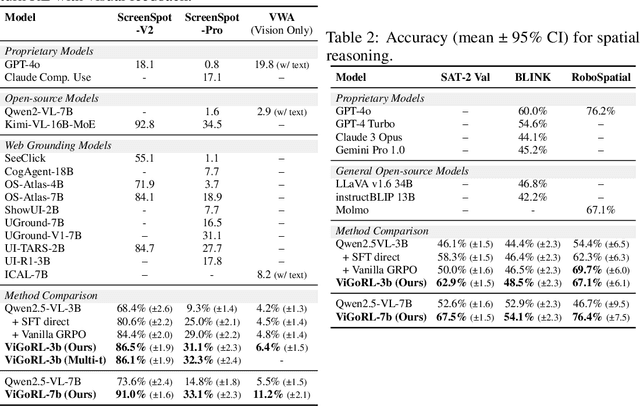

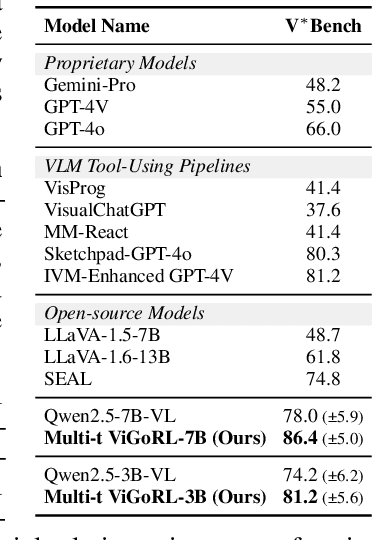
Abstract:While reinforcement learning (RL) over chains of thought has significantly advanced language models in tasks such as mathematics and coding, visual reasoning introduces added complexity by requiring models to direct visual attention, interpret perceptual inputs, and ground abstract reasoning in spatial evidence. We introduce ViGoRL (Visually Grounded Reinforcement Learning), a vision-language model trained with RL to explicitly anchor each reasoning step to specific visual coordinates. Inspired by human visual decision-making, ViGoRL learns to produce spatially grounded reasoning traces, guiding visual attention to task-relevant regions at each step. When fine-grained exploration is required, our novel multi-turn RL framework enables the model to dynamically zoom into predicted coordinates as reasoning unfolds. Across a diverse set of visual reasoning benchmarks--including SAT-2 and BLINK for spatial reasoning, V*bench for visual search, and ScreenSpot and VisualWebArena for web-based grounding--ViGoRL consistently outperforms both supervised fine-tuning and conventional RL baselines that lack explicit grounding mechanisms. Incorporating multi-turn RL with zoomed-in visual feedback significantly improves ViGoRL's performance on localizing small GUI elements and visual search, achieving 86.4% on V*Bench. Additionally, we find that grounding amplifies other visual behaviors such as region exploration, grounded subgoal setting, and visual verification. Finally, human evaluations show that the model's visual references are not only spatially accurate but also helpful for understanding model reasoning steps. Our results show that visually grounded RL is a strong paradigm for imbuing models with general-purpose visual reasoning.
TAPIP3D: Tracking Any Point in Persistent 3D Geometry
Apr 20, 2025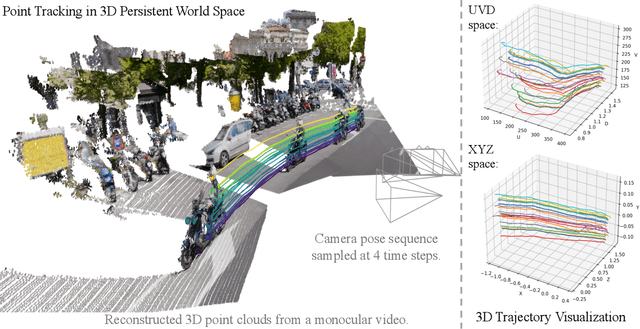



Abstract:We introduce TAPIP3D, a novel approach for long-term 3D point tracking in monocular RGB and RGB-D videos. TAPIP3D represents videos as camera-stabilized spatio-temporal feature clouds, leveraging depth and camera motion information to lift 2D video features into a 3D world space where camera motion is effectively canceled. TAPIP3D iteratively refines multi-frame 3D motion estimates within this stabilized representation, enabling robust tracking over extended periods. To manage the inherent irregularities of 3D point distributions, we propose a Local Pair Attention mechanism. This 3D contextualization strategy effectively exploits spatial relationships in 3D, forming informative feature neighborhoods for precise 3D trajectory estimation. Our 3D-centric approach significantly outperforms existing 3D point tracking methods and even enhances 2D tracking accuracy compared to conventional 2D pixel trackers when accurate depth is available. It supports inference in both camera coordinates (i.e., unstabilized) and world coordinates, and our results demonstrate that compensating for camera motion improves tracking performance. Our approach replaces the conventional 2D square correlation neighborhoods used in prior 2D and 3D trackers, leading to more robust and accurate results across various 3D point tracking benchmarks. Project Page: https://tapip3d.github.io
Unified Multimodal Discrete Diffusion
Mar 26, 2025Abstract:Multimodal generative models that can understand and generate across multiple modalities are dominated by autoregressive (AR) approaches, which process tokens sequentially from left to right, or top to bottom. These models jointly handle images, text, video, and audio for various tasks such as image captioning, question answering, and image generation. In this work, we explore discrete diffusion models as a unified generative formulation in the joint text and image domain, building upon their recent success in text generation. Discrete diffusion models offer several advantages over AR models, including improved control over quality versus diversity of generated samples, the ability to perform joint multimodal inpainting (across both text and image domains), and greater controllability in generation through guidance. Leveraging these benefits, we present the first Unified Multimodal Discrete Diffusion (UniDisc) model which is capable of jointly understanding and generating text and images for a variety of downstream tasks. We compare UniDisc to multimodal AR models, performing a scaling analysis and demonstrating that UniDisc outperforms them in terms of both performance and inference-time compute, enhanced controllability, editability, inpainting, and flexible trade-off between inference time and generation quality. Code and additional visualizations are available at https://unidisc.github.io.
Unifying 2D and 3D Vision-Language Understanding
Mar 13, 2025Abstract:Progress in 3D vision-language learning has been hindered by the scarcity of large-scale 3D datasets. We introduce UniVLG, a unified architecture for 2D and 3D vision-language understanding that bridges the gap between existing 2D-centric models and the rich 3D sensory data available in embodied systems. Our approach initializes most model weights from pre-trained 2D models and trains on both 2D and 3D vision-language data. We propose a novel language-conditioned mask decoder shared across 2D and 3D modalities to ground objects effectively in both RGB and RGB-D images, outperforming box-based approaches. To further reduce the domain gap between 2D and 3D, we incorporate 2D-to-3D lifting strategies, enabling UniVLG to utilize 2D data to enhance 3D performance. With these innovations, our model achieves state-of-the-art performance across multiple 3D vision-language grounding tasks, demonstrating the potential of transferring advances from 2D vision-language learning to the data-constrained 3D domain. Furthermore, co-training on both 2D and 3D data enhances performance across modalities without sacrificing 2D capabilities. By removing the reliance on 3D mesh reconstruction and ground-truth object proposals, UniVLG sets a new standard for realistic, embodied-aligned evaluation. Code and additional visualizations are available at $\href{https://univlg.github.io}{univlg.github.io}$.
Video Depth without Video Models
Nov 28, 2024Abstract:Video depth estimation lifts monocular video clips to 3D by inferring dense depth at every frame. Recent advances in single-image depth estimation, brought about by the rise of large foundation models and the use of synthetic training data, have fueled a renewed interest in video depth. However, naively applying a single-image depth estimator to every frame of a video disregards temporal continuity, which not only leads to flickering but may also break when camera motion causes sudden changes in depth range. An obvious and principled solution would be to build on top of video foundation models, but these come with their own limitations; including expensive training and inference, imperfect 3D consistency, and stitching routines for the fixed-length (short) outputs. We take a step back and demonstrate how to turn a single-image latent diffusion model (LDM) into a state-of-the-art video depth estimator. Our model, which we call RollingDepth, has two main ingredients: (i) a multi-frame depth estimator that is derived from a single-image LDM and maps very short video snippets (typically frame triplets) to depth snippets. (ii) a robust, optimization-based registration algorithm that optimally assembles depth snippets sampled at various different frame rates back into a consistent video. RollingDepth is able to efficiently handle long videos with hundreds of frames and delivers more accurate depth videos than both dedicated video depth estimators and high-performing single-frame models. Project page: rollingdepth.github.io.
Deep Generative Models in Robotics: A Survey on Learning from Multimodal Demonstrations
Aug 08, 2024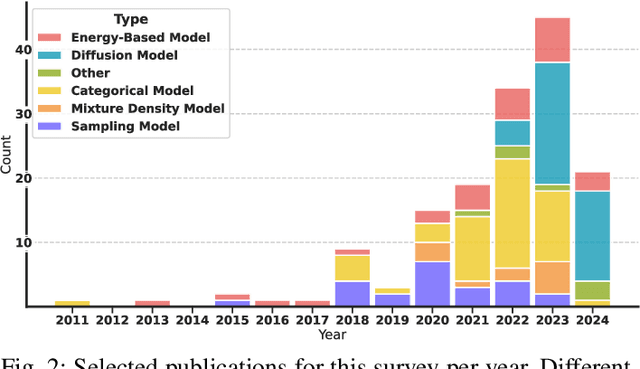


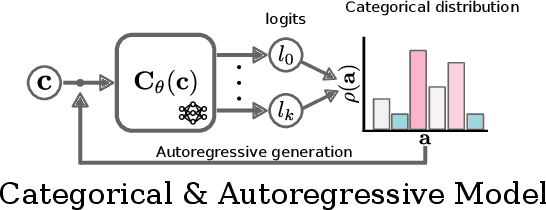
Abstract:Learning from Demonstrations, the field that proposes to learn robot behavior models from data, is gaining popularity with the emergence of deep generative models. Although the problem has been studied for years under names such as Imitation Learning, Behavioral Cloning, or Inverse Reinforcement Learning, classical methods have relied on models that don't capture complex data distributions well or don't scale well to large numbers of demonstrations. In recent years, the robot learning community has shown increasing interest in using deep generative models to capture the complexity of large datasets. In this survey, we aim to provide a unified and comprehensive review of the last year's progress in the use of deep generative models in robotics. We present the different types of models that the community has explored, such as energy-based models, diffusion models, action value maps, or generative adversarial networks. We also present the different types of applications in which deep generative models have been used, from grasp generation to trajectory generation or cost learning. One of the most important elements of generative models is the generalization out of distributions. In our survey, we review the different decisions the community has made to improve the generalization of the learned models. Finally, we highlight the research challenges and propose a number of future directions for learning deep generative models in robotics.
 Add to Chrome
Add to Chrome Add to Firefox
Add to Firefox Add to Edge
Add to Edge